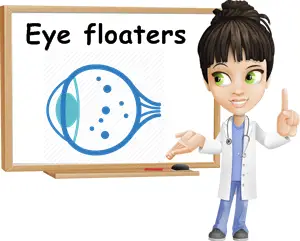Eye floaters represent a common form of visual disturbance. They appear as different shapes of small size such as spots, dots, flecks, cells, webs, worms or threads which move about one’s field of vision.
Eye floaters may be bothersome, but they are generally a benign condition which should not interfere with normal vision. Unlike visual aura, which is strictly a perceptual disturbance or an optical illusion, floaters are actually the shadows cast by deposits that are physically present in one’s eye.
While our brain can, in time, learn to ignore them, floaters should be checked out when they become particularly bothersome because they may be a sign of retina tear or retinal detachment, conditions which put us at risk of losing our eyesight.

What are floaters?
Eye floaters or simply floaters are also known as myodesopsia or flying flies (from the French mouches volantes). They are basically deposits in our vitreous humour (part of the eye between the lens and the retina that is filled with a clear, gelatinous substance) which cast a shadow on the retina. This shadow of the deposits that appears in our field of vision is what we call floaters.
What is the difference between floaters and visual aura?
Eye floaters are not the same things as visual aura. The bright, shimmering lines, blobs or dots common in visual aura are only an optical illusion or a distortion of our visual perception.
They have no physical source. Floaters on the other hand are the shadows cast on the retina by various types of deposits located in the vitreous humour. And the causes for these deposits in the eyes are diverse, ranging from injury, retina detachment to candida infections.
What do floaters look like?
General appearance
Floaters are often transparent, but can be whitish, gray or even black in color, depending on the consistency of the deposits in the vitreous humour. The shape of the deposits also dictates the shape of the floaters. Generally, eye floaters are a benign condition, mainly because the floaters are quite insignificant and are nothing more than annoying as they move about one’s field of vision. The closer a deposit is to the retina, the larger its shadow, the floater, appears.

There are several types of deposits that can cast a shadow on the retina and lead to the formation of floaters. These include:
- Retina fragments.
- Collagen fibrils (fine fragments).
- Cells and cell matter.
- Red blood cells.
- White blood cells.
- Calcium material.
- Solid matter from the vitreous humour.
Depending on the deposits casting a shadow on the retina, floaters may have various shapes, sizes and even colors:
- Spots, dots or blobs.
- Threads or strands.
- Webs.
- Flecks or specks.
- Squiggly lines.
- Ring shapes.
Why do eye floaters move?
As mentioned above, floaters are deposits in the vitreous humour, a gel-like part of the eye located in between the lens and the retina. These deposits are not fixed so they move about the vitreous and so do their shadows.
This is what causes them to appear to move or drift about our field of vision. This is also one of the reasons they are visible to us.
Floaters also appear to be following every movement our eyes make when, in fact, they are only drifting or moving about in the vitreous humour aimlessly. In other words, they do not actually move when we turn our eyes in one direction or another.
We just continue to see them wherever we look simply because they are in our field of vision.
Many people report seeing floaters more clearly when looking at the blue sky, for example. The explanation is simple: the blue sky is like the simplest background possible and it allows us to better observe the floaters as they are not competing for our attention with any other significant object. Also, it has been shown that they tend to drift towards the bottom of the eye so looking up at the sky will position them in the center of our field of vision and make them easier to observe. Bright daylight can also make floaters more visible to us.
What causes eye floaters?
Why do eye floaters appear? There are several possible causes for why they appear:
1) Old age
As we grow old, our vitreous humour tends to shrinks and solid matter may break free, resulting in floaters. People over the age of 50, those suffering from nearsightedness (myopia) or anyone having undergone cataract surgery may experience floaters. While floaters are very likely to occur in the elderly, children, teenagers and young adults may also experience them. Generally, floaters are a benign condition.
2) Vitreous humour detachment and retina tear
It is possible for the vitreous humour to break off from the retina. During this process, the viterous humour may drag part of the retina with it and cause a tear. This may result in floaters and flashes. If flashes occur, seek medical help at once.
3) Detachment of the retina
Vitreous humor detachment, retinal tear and traumatic accidents may cause the retina to detach. This may result in hemorrhage and the appearance of a great number of dot-like floaters or flashes of light along with vision loss. If you suspect a retina detachment, please see a medical professional immediately.
4) Inflammation of the vitreous humour or retina
Inflammation at the level of the vitreous humour and retina may be caused by trauma, disease such as chorioretinitis, viral or fungal infections such as candida infections and can lead to floaters. Being a serious condition, it requires immediate medical attention.
5) Disease
Diabetes may cause diabetic retinopathy, a condition which leads to the destruction of blood vessels connected to the retina and blindness. HIV and AIDS as well as syphilis, tuberculosis or West Nile virus may cause chorioretinitis and subsequent inflammation of the retina and vitreous humour, resulting in floaters. Eye floaters may appear, in extremely rare cases, as a result of cancer, benign tumors or asteroid hyalosis, which is a disease that causes tiny, asteroid or star-shaped white opacities located in the vitreous humour.
6) Trauma and injury
Trauma and injury are most likely to cause vitreous humour hemorrhage, vitreous detachment, retina tear and detachment and thus lead to floaters and even blindness.
What to look out for
Are floaters normal or dangerous?
As mentioned above, eye floaters are usually a harmless medical condition. Floaters may appear and go away or be present for the most part of one’s life. As long as they do not interfere with normal vision, they are no reason for concern.
However, it might be best to seek medical help if you notice any of the following symptoms:
- Floaters increase in number and start affecting your eyesight.
- They are accompanied by flashes.
- Vision loss occurs.
- Pain develops.
- You experience redness, itching, excess tearing.
Any of these symptoms may be a sign of vitreous or retina detachment, hemorrhage or indicate an underlying disease. Generally, floaters should be inconvenient at the most, but not affect vision, engender pain or bright flashes of light.
Treatment options for eye floaters
Eye floaters is a medical condition that does not require treatment unless it causes vision impairment. It has been shown that our brain will eventually learn to tune out the presence of the floaters.
Children, teenagers and even young adults may experience singular episodes, with floaters eventually disappearing. Some people report taking magnesium supplements to help improve the condition but research is lacking on the subject.
In severe cases, a surgery called vitrectomy may be performed to remove part of the vitreous humour (the floater-deposits are too small to be removed individually).
The risks of the procedure include: retina detachment, bleeding, infection, cataract and blindness. A novelty laser surgery called vitreolysis may be performed to remove deposits, but holds similar risks.
The advantage is that it is less invasive and boasts an up to 90% success rate.
